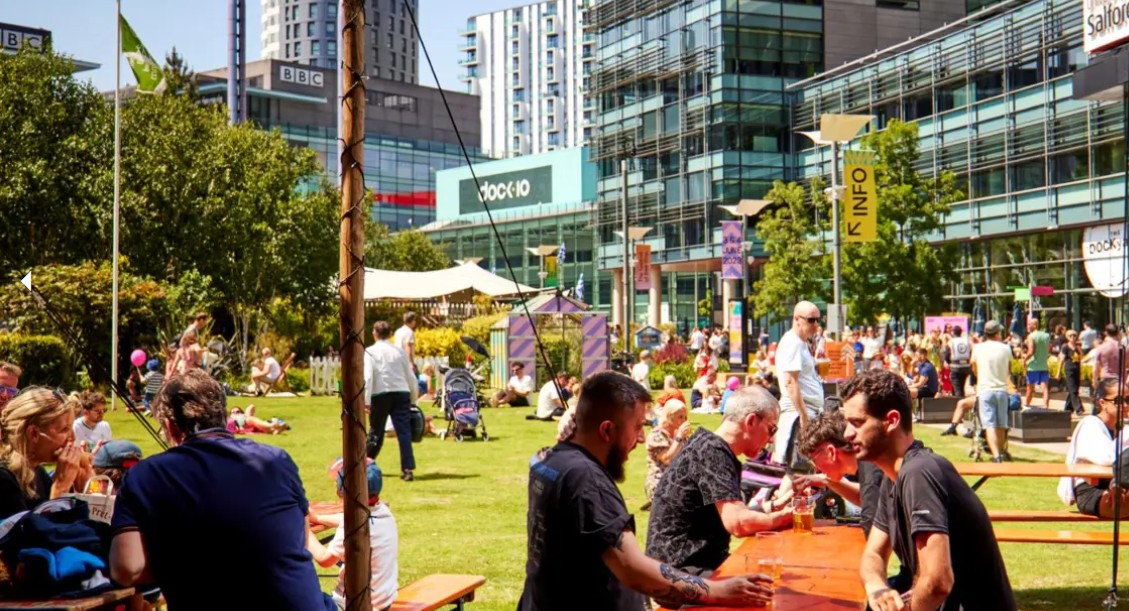Salford's £1 billion visitor economy boom
- Salford is the largest visitor economy contributor outside of Manchester Local Authority valued at £1 billion, up 42%.
- Supporting over 10,100 full-time equivalent jobs, up 38%.
- Visits up 10% to a record 8 million.

With its unique waterfront destinations of The Quays and MediaCity, leading attractions of Lowry and RHS Garden Bridgewater blended with sporting heritage and cultural events including the hugely popular ‘We Invented the Weekend Festival’, Salford is a contemporary thriving mix of modern and historic which saw 8 million visits generating an economic impact of £1 billion in 2023.
The latest 2023 data from Marketing Manchester, who measure tourism activity through the Global Tourism Solutions (UK) STEAM model for Greater Manchester (GM), places Salford as the largest visitor economy contributor outside of Manchester within GM.
The boost in Salford’s profile has seen the city become one of the fastest growing places in the North of England, with the 2023 trends showing an increase of:
- 42% in economic impact to £1.05 billion (from £735.4 million)
- 38% in jobs supporting 10,100 (from 7,330)
- 10% in total visits to 8.0 million (from 7.3 million)
At the heart of the city’s growth is the thriving creative and technology sector, which has grown by over 50% since 2019, created 32,000 jobs and is a major global hub to over 2,000 industry leading creative and digital businesses including broadcasting, digital consultancy, and film/TV production.
In total, Salford has the second largest creative industries sector in GM, which stands as a beacon for the government’s 10 year Creative Industries Sector Plan as part of its new UK's Modern Industrial Strategy 2025 to ensure long‑term economic growth across the UK.
This growth in the creative and technology sector has been matched by Salford’s visitor economy, bringing new investment opportunities that have seen a 31% increase in hotels, B&Bs, bars, cafes and restaurants in the last five years, strengthening the ties between tourism and the digital industries.
Drawing in visitors to the city has also been driven by the wealth of historic and culturally significant buildings, a thriving artistic community and a diverse range of leisure opportunities, green spaces, parks and waterways, making it an attractive location for visitors.
From the vibrant areas of the City Centre to the home to the region’s most visited cultural attraction, Lowry, which recently celebrated its 25th birthday, there is significant potential to support the further growth of Salford’s tourism and cultural economy. This will also help in further raising the city’s profile and also in providing employment, creative and leisure opportunities for local residents.
Councillor Hannah Robinson-Smith, Lead Member for Culture, Heritage, Equalities, Sports and Leisure at Salford City Council said: “These figures are testament to the partnerships in place to promote the city and the vital role Salford plays as a key destination in the North.
“Salford’s impressive growth and regeneration has brought many benefits and a positive impact, with more jobs, new affordable and social homes, cleaner transport and a vibrant creative and cultural scene alongside local heritage assets and iconic infrastructure.
“The city is full of ambition, opportunity, and innovation, and the continued drive by the council and other partners to put the city and region on the map will ensure that these figures will keep on rising and creating a place where people want to live, work, invest and visit.”
Looking to the future, Salford City Council is determined to build on these successes and ensure more people and communities can benefit from the growing opportunities the city has to offer.
Over the next two decades Salford is forecast to experience the fastest growth in Greater Manchester, with the local economy expected to increase by over 46% with £3 billion of growth.



